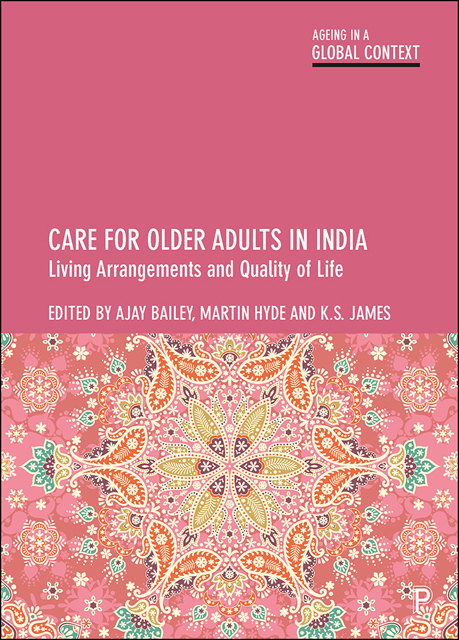Book contents
- Frontmatter
- Contents
- List of figures and tables
- Notes on the editors
- List of contributors
- Acknowledgements
- Series editors’ preface
- Map of India
- 1 Introduction: Living arrangements and care in India
- 2 Theorising care and relationships in the age of migration
- 3 Emerging living arrangements of older adults in India: patterns and welfare implications
- 4 Living arrangement concordance and the well-being of older persons in India
- 5 Family size and living arrangements among older adults in Kerala: panel data analysis, 2004– 19
- 6 Care arrangements for older adults: exploring the intergenerational contract in emigrant households of Goa, India
- 7 All my responsibilities towards my children are over! Linked lives and life course obligations among older adults with migrant children in India
- 8 Interpreting the landscapes of care for older men in Delhi and Kolkata: perspectives from care receivers and caregivers
- 9 The role of cultural meaning system and place attachment in retaining home ownership while residing in retirement homes in Kerala, India
- 10 Decision-making and choice or sine qua non? Care home entry in Tamil Nadu
- 11 Welfare and development programmes for older adults in India
- 12 Lessons and future directions for caregiving research in India
- Index
2 - Theorising care and relationships in the age of migration
Published online by Cambridge University Press: 13 October 2022
- Frontmatter
- Contents
- List of figures and tables
- Notes on the editors
- List of contributors
- Acknowledgements
- Series editors’ preface
- Map of India
- 1 Introduction: Living arrangements and care in India
- 2 Theorising care and relationships in the age of migration
- 3 Emerging living arrangements of older adults in India: patterns and welfare implications
- 4 Living arrangement concordance and the well-being of older persons in India
- 5 Family size and living arrangements among older adults in Kerala: panel data analysis, 2004– 19
- 6 Care arrangements for older adults: exploring the intergenerational contract in emigrant households of Goa, India
- 7 All my responsibilities towards my children are over! Linked lives and life course obligations among older adults with migrant children in India
- 8 Interpreting the landscapes of care for older men in Delhi and Kolkata: perspectives from care receivers and caregivers
- 9 The role of cultural meaning system and place attachment in retaining home ownership while residing in retirement homes in Kerala, India
- 10 Decision-making and choice or sine qua non? Care home entry in Tamil Nadu
- 11 Welfare and development programmes for older adults in India
- 12 Lessons and future directions for caregiving research in India
- Index
Summary
Introduction
This chapter provides a theoretical framework to understand the ways in which living arrangements and the provision of care for older people in India have been affected by migration. According to the United Nations, as of 2020 nearly 18 million Indians were living outside their country of origin. Indians are the largest diaspora groups followed by Mexican, Russian and Chinese diasporas (UNDESA, 2020). The largest concentration of Indian international migrants is in the Gulf region. The international migration from India prior to 2000 was largely low skilled and more focused towards the Middle East. After 2000 rapid globalisation increased the migration of skilled workers to the developed countries. Much of this skilled migration was among middle-class households and followed a trajectory where education and employment mobility to cities fuelled further migration plans to other countries. Indian migrants also contribute a large portion of their incomes as remittances. According to the World Bank, India received close to $US84 billion as remittances in 2019, close to 2.8 per cent of its GDP. Due to the COVID pandemic the World Bank estimates that remittances could drop by between 7 and 9 per cent (Ratha et al, 2020).
However, as eye-catching as these figures are, it is important to remember that the number of internal migrants within India is far greater than those who migrate abroad. Increasing urbanisation, improvement of travel and access to travel, coupled with greater educational opportunities, has led to widespread migration within India. Migration to the cities is driven by a combination of labour migration, which can be both temporary and circular, educational mobility and marriage migration. Bhagat's (2016) analysis of the 2011 census data shows that nearly 30 per cent of the Indian population moved internally. De (2019) reports that there were 450 million internal migrants in India and much of this migration was intra-state migration. See Chapter 3 by James and Kumar on the impact of migration on living arrangements of older adults in India. The lower levels of interstate migration could potentially be due to the non-transferability of social security entitlements across state borders (Kone et al 2018).
- Type
- Chapter
- Information
- Care for Older Adults in IndiaLiving Arrangements and Quality of Life, pp. 12 - 24Publisher: Bristol University PressPrint publication year: 2022



